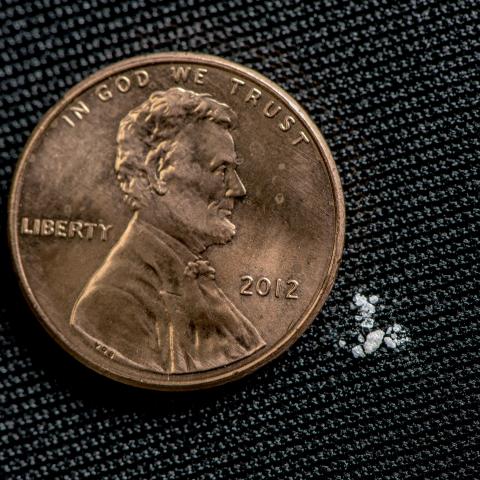Fentanyl: the greatest threat in the opioid crisis?
Update: 8/21/2024
NATIONAL FENTANYL PREVENTION AND AWARENESS DAY AUGUST 21
check out the video below from the DEA and download a Fentanyl information packet HERE.
What is Fentanyl?
Fentanyl is a powerful synthetic opioid drug with significant medical applications, primarily as a pain reliever and anesthetic. In recent years, its misuse and abuse have become a major public health concern. In this blog post, we will delve into the details of fentanyl, its origin, effects, abuse potential, and the alarming rise in overdose deaths associated with its illicit use. It is approximately 100 times stronger than morphine and 50 times stronger than heroin in terms of pain relief. It is a potent analgesic, meaning it can effectively alleviate severe pain. However, its potency also increases the risk of misuse and overdose.

Lethal dose of fentanyl seen next to a penny.
Origin and Legitimate Use:
Fentanyl was developed in the late 1950s and introduced as an intravenous anesthetic in the 1960s. Legally, it is manufactured and distributed in the United States. However, diversion and misuse of licit fentanyl pharmaceutical products have been observed, involving activities such as theft, fraudulent prescriptions, and illicit distribution by various individuals, including patients, healthcare professionals, and pharmacists.
The Rise of Illicit Fentanyl:
In recent years, the misuse of illicitly produced fentanyl and its analogs has led to a significant increase in fatal overdoses and encounters with law enforcement. According to the CDC, the number of drug overdose deaths involving synthetic opioids (excluding methadone) has been rising dramatically. In 2021 alone, there were over 68,000 overdose deaths related to fentanyl. From 2013 to 2021, the total number of overdose deaths involving synthetic opioids exceeded 258,000. These alarming statistics highlight the urgency to address the illicit production and distribution of fentanyl.
Street Names and Appearance:
Fentanyl is known by various street names such as Apache, China Girl, Dance Fever, and more. Illicitly produced fentanyl can be encountered in the form of a powder or fake tablets, often sold alone or mixed with other substances like heroin or cocaine. It is crucial to be aware of these street names and the potential risks associated with counterfeit fentanyl products.
Methods of Abuse:
Fentanyl can be abused through different routes, including injection, snorting, smoking, and oral ingestion. It is frequently mixed with other drugs, and fake pills resembling pharmaceutical drugs like oxycodone have been discovered containing fentanyl. Some individuals misuse fentanyl patches by extracting the gel and injecting or ingesting its contents. Others freeze the patches, cut them into pieces, and place them under the tongue or in the cheek cavity. The increase in reported fentanyl cases by forensic laboratories underscores the concerning prevalence of fentanyl abuse.
Effects on the Body:
Similar to other opioids, fentanyl produces a range of effects on the body. It can induce relaxation, euphoria, pain relief, sedation, confusion, drowsiness, dizziness, nausea, vomiting, urinary retention, pupillary constriction, and respiratory depression. These effects make it a highly sought-after drug of abuse.
The Dangers of Overdose:
One of the gravest risks associated with fentanyl use is overdose. Taking too much fentanyl can lead to severe consequences, including stupor, changes in pupillary size, cold and clammy skin, cyanosis, coma, and respiratory failure, which can ultimately result in death. Recognizing the symptoms of opioid poisoning, such as coma, pinpoint pupils, and respiratory depression, is crucial for prompt intervention and potentially saving lives.
Similar Drugs and Legal Status:
Other opioids, including morphine, hydrocodone, oxycodone, hydromorphone, methadone, and heroin, share similar
effects with fentanyl. These drugs also pose a risk of misuse and overdose. Under the United States Controlled Substances Act of 1970, fentanyl is classified as a Schedule II narcotic, highlighting its potential for abuse and the need for strict regulation.
Conclusion:
Fentanyl, a potent synthetic opioid, has brought both significant benefits in the medical field and numerous challenges due to its misuse. The illicit production and distribution of fentanyl have contributed to a devastating increase in overdose deaths. Understanding the dangers associated with fentanyl, recognizing its street names and appearances, and being aware of the potential risks of misuse are essential steps in addressing this public health crisis. By promoting education, prevention, and access to proper treatment, we can combat the fentanyl epidemic and strive for a safer and healthier future.
The learn how you can help keep your company and community safe from this dangerous narcotic give us a call at 1-888-201-0242 or contact us today.

Update: 8/21/24
NATIONAL FENTANYL PREVENTION AND AWARENESS DAY AUGUST 21
check out the video below from the DEA and download a Fentanyl information packet HERE.
